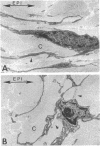Abstract
Regeneration of the dermis does not occur spontaneously in the adult mammal. The epidermis is regenerated spontaneously provided there is a dermal substrate over which it can migrate. Certain highly porous, crosslinked collagen-glycosaminoglycan copolymers have induced partial morphogenesis of skin when seeded with dermal and epidermal cells and then grafted on standard, full-thickness skin wounds in the adult guinea pig. A mature epidermis and a nearly physiological dermis, which lacked hair follicles but was demonstrably different from scar, were regenerated over areas as large as 16 cm2. These chemical analogs of extracellular matrices were morphogenetically active provided that the average pore diameter ranged between 20 and 125 microns, the resistance to degradation by collagenase exceeded a critical limit, and the density of autologous dermal and epidermal cells inoculated therein was greater than 5 x 10(4) cells per cm2 of wound area. Unseeded copolymers with physical structures that were within these limits delayed the onset of wound contraction by about 10 days but did not eventually prevent it. Seeded copolymers not only delayed contraction but eventually arrested and reversed it while new skin was being regenerated. The data identify a model extracellular matrix that acts as if it were an insoluble growth factor with narrowly specified physiochemical structure, functioning as a transient basal lamina during morphogenesis of skin.
Full text
PDF




Images in this article
Selected References
These references are in PubMed. This may not be the complete list of references from this article.
- BILLINGHAM R. E., MEDAWAR P. B. Contracture and intussusceptive growth in the healing of extensive wounds in mammalian skin. J Anat. 1955 Jan;89(1):114–123. [PMC free article] [PubMed] [Google Scholar]
- Bourin M. C., Delescluse C., Fürstenberger G., Marks F., Schweizer J., Klein-Szanto A. J., Prunieras M. Effect of phorbol esters on guniea pig skin in vivo. Carcinogenesis. 1982;3(6):671–676. doi: 10.1093/carcin/3.6.671. [DOI] [PubMed] [Google Scholar]
- Burke J. F., Yannas I. V., Quinby W. C., Jr, Bondoc C. C., Jung W. K. Successful use of a physiologically acceptable artificial skin in the treatment of extensive burn injury. Ann Surg. 1981 Oct;194(4):413–428. doi: 10.1097/00000658-198110000-00005. [DOI] [PMC free article] [PubMed] [Google Scholar]
- Dagalakis N., Flink J., Stasikelis P., Burke J. F., Yannas I. V. Design of an artificial skin. Part III. Control of pore structure. J Biomed Mater Res. 1980 Jul;14(4):511–528. doi: 10.1002/jbm.820140417. [DOI] [PubMed] [Google Scholar]
- GRILLO H. C., WATTS G. T., GROSS J. Studies in wound healing: I. Contraction and the wound contents. Ann Surg. 1958 Aug;148(2):145–160. doi: 10.1097/00000658-195808000-00001. [DOI] [PMC free article] [PubMed] [Google Scholar]
- Gabbiani G., Ryan G. B., Majne G. Presence of modified fibroblasts in granulation tissue and their possible role in wound contraction. Experientia. 1971 May 15;27(5):549–550. doi: 10.1007/BF02147594. [DOI] [PubMed] [Google Scholar]
- Gordon P. L., Huang C., Lord R. C., Yannas I. V. The far-infrared spectrum of collagen. Macromolecules. 1974 Nov-Dec;7(6):954–956. doi: 10.1021/ma60042a052. [DOI] [PubMed] [Google Scholar]
- Heimbach D., Luterman A., Burke J., Cram A., Herndon D., Hunt J., Jordan M., McManus W., Solem L., Warden G. Artificial dermis for major burns. A multi-center randomized clinical trial. Ann Surg. 1988 Sep;208(3):313–320. doi: 10.1097/00000658-198809000-00008. [DOI] [PMC free article] [PubMed] [Google Scholar]
- MANDL I., MACLENNAN J. D., HOWES E. L. Isolation and characterization of proteinase and collagenase from Cl. histolyticum. J Clin Invest. 1953 Dec;32(12):1323–1329. doi: 10.1172/JCI102861. [DOI] [PMC free article] [PubMed] [Google Scholar]
- Nimni M. E. Collagen: structure, function, and metabolism in normal and fibrotic tissues. Semin Arthritis Rheum. 1983 Aug;13(1):1–86. doi: 10.1016/0049-0172(83)90024-0. [DOI] [PubMed] [Google Scholar]
- Regnier M., Delescluse C., Prunieras M. Studies on guinea pig skin cell cultures. I. Separate cultures of keratinocytes and dermal fibroblasts. Acta Derm Venereol. 1973;53(4):241–247. [PubMed] [Google Scholar]
- Smith L. T., Holbrook K. A., Byers P. H. Structure of the dermal matrix during development and in the adult. J Invest Dermatol. 1982 Jul;79 (Suppl 1):93s–104s. doi: 10.1111/1523-1747.ep12545877. [DOI] [PubMed] [Google Scholar]
- Yannas I. V., Burke J. F. Design of an artificial skin. I. Basic design principles. J Biomed Mater Res. 1980 Jan;14(1):65–81. doi: 10.1002/jbm.820140108. [DOI] [PubMed] [Google Scholar]
- Yannas I. V., Burke J. F., Huang C., Gordon P. L. Correlation of in vivo collagen degradation rate with in vitro measurements. J Biomed Mater Res. 1975 Nov;9(6):623–628. doi: 10.1002/jbm.820090608. [DOI] [PubMed] [Google Scholar]
- Yannas I. V., Burke J. F., Orgill D. P., Skrabut E. M. Wound tissue can utilize a polymeric template to synthesize a functional extension of skin. Science. 1982 Jan 8;215(4529):174–176. doi: 10.1126/science.7031899. [DOI] [PubMed] [Google Scholar]
- Yannas I. V., Tobolsky A. V. Cross-linking of gelatine by dehydration. Nature. 1967 Jul 29;215(5100):509–510. doi: 10.1038/215509b0. [DOI] [PubMed] [Google Scholar]






